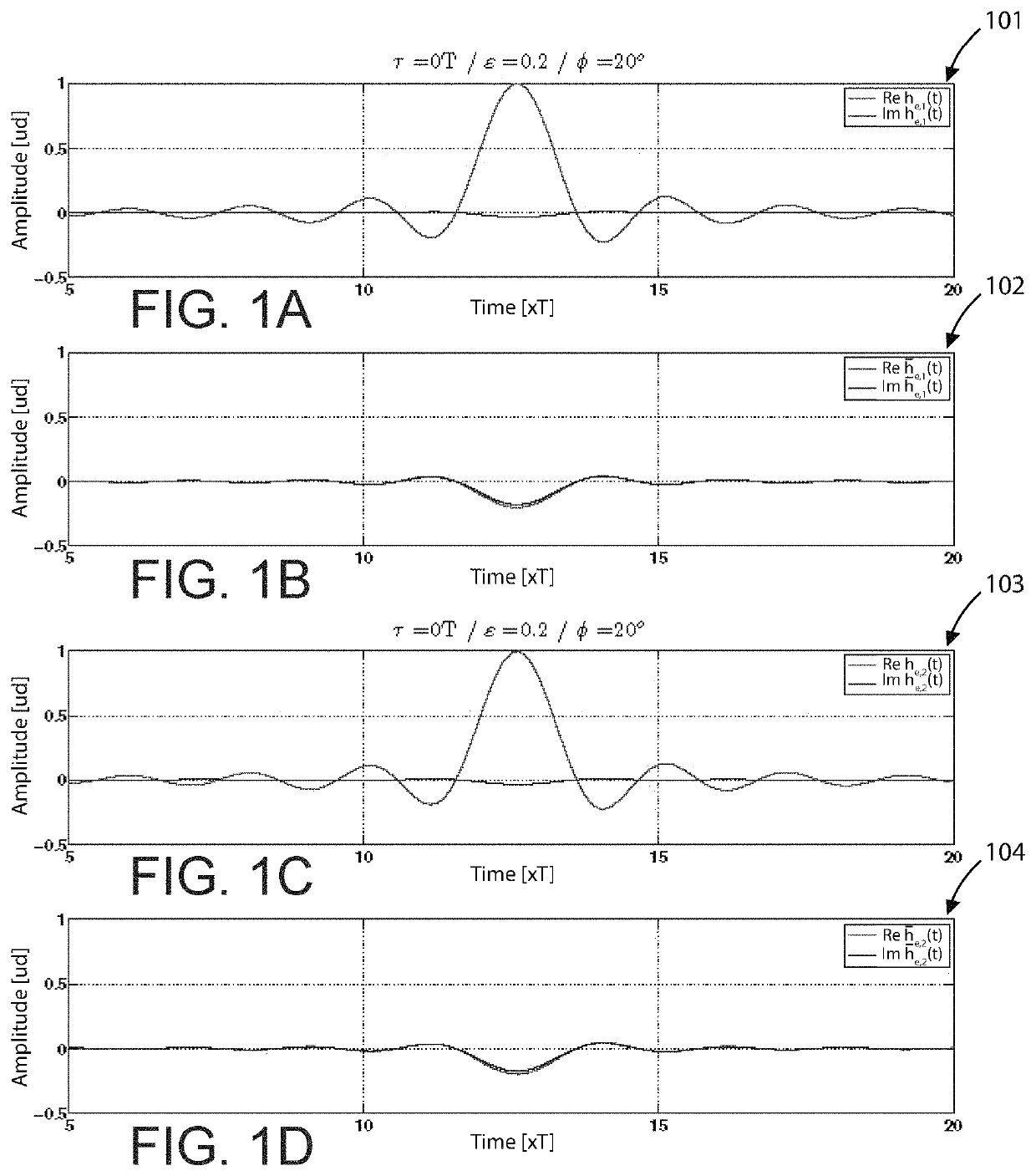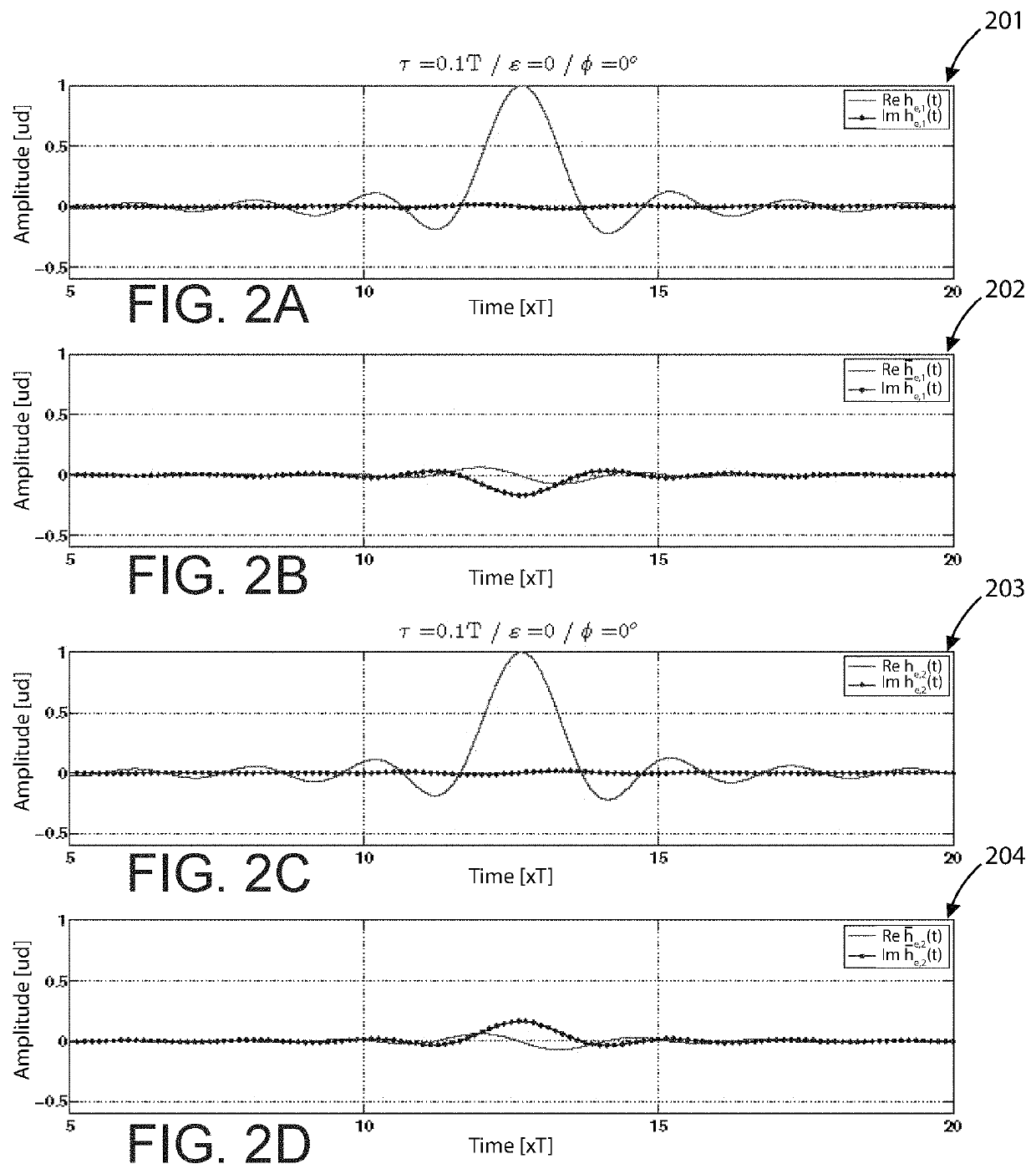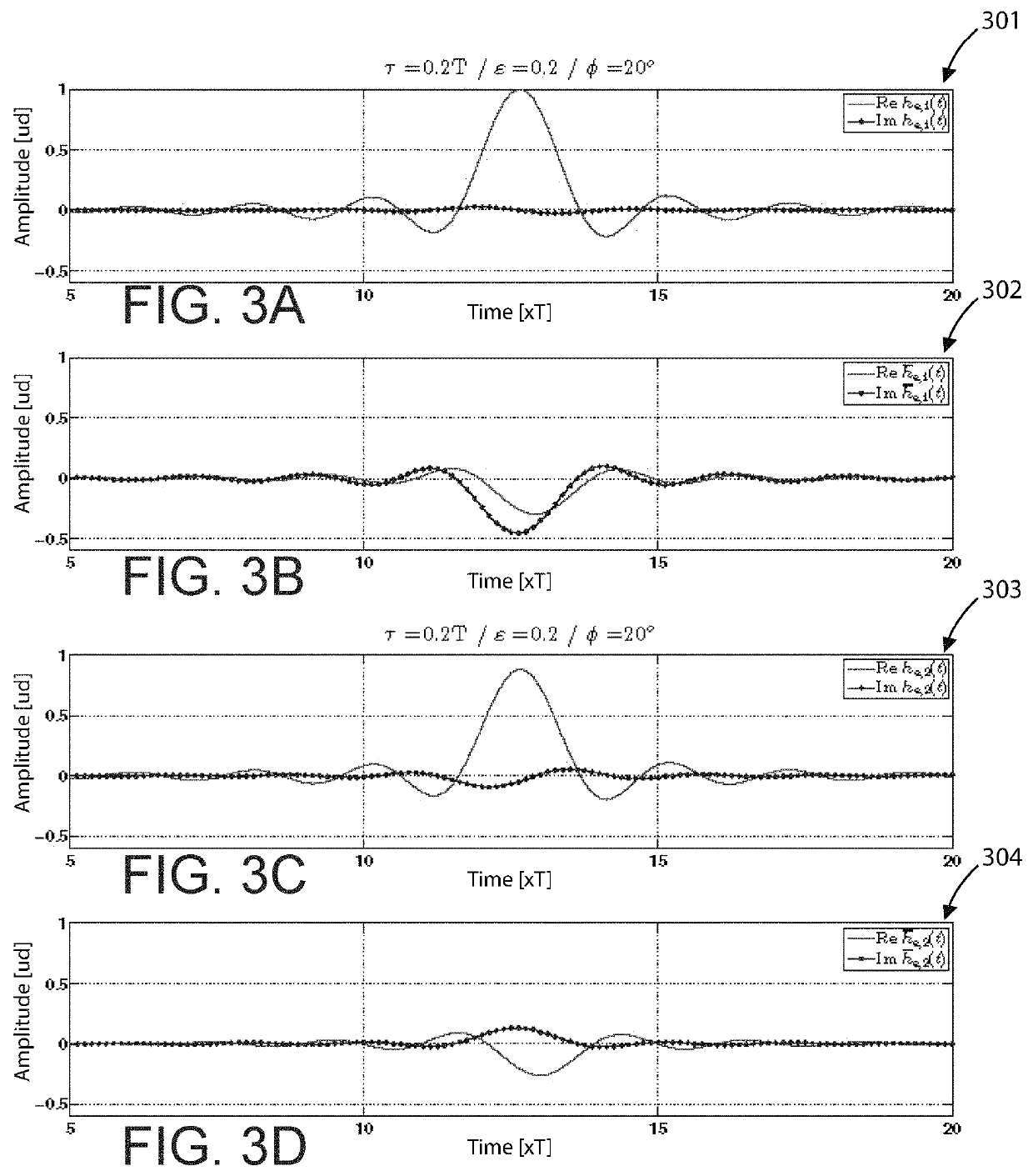Impairment compensation techniques for high performance coherent optical transceivers
a technology of interference compensation and coherent optical transmission, which is applied in the field of optical communication improvement methods and devices, can solve the problems that the phase and gain imbalance of the modulator (tx) cannot be completely compensated at the receiver
- Summary
- Abstract
- Description
- Claims
- Application Information
AI Technical Summary
Benefits of technology
Problems solved by technology
Method used
Image
Examples
case 1
A. Impact of Quadrature Error (τ=0)
[0052]In the absence of I / Q skew (i.e., τ=0), the following can be determined:
f(t)=αδ(t)
f(t)=βδ(t)
Since f(t)e±jωct=αδ(t)e±jωct=αδ(t) and f(t)e±jωct=βδ(t)e±jωct=βδ(t), the following can be determined:
he,1(t)=he,2(t)=αg(t)
he,1(t)=he,2(t)=βg(t)
[0053]FIGS. 1A-1D are sample graphs illustrating simulation channel responses according to examples of the present invention. More specifically, graphs 101-104 show simulation responses under the following criteria: τ=0 T, ∈=0.2, and ϕ=20°. These results confirm the predictions previously discussed.
[0054]Next, we evaluate the impact and compensation of the quadrature error on the receiver. Assuming that g(t) is an ISI-free pulse, we can verify that the baud rate samples of the signals for a same polarization of both subcarriers result as follows:
r1,x(n)=ααn,1+βαn,2* (27)
r2,x(n)=ααn,2+βαn,1* (28)
Note that an,1 and an,2* can be detected (instead of an,2) by considering the equivalent system as follows:
r1,x(n)=α...
case 2
B. Impact of IQ Skew (∈=0 and ϕ=0)
[0065]In this case, we get the following:
[0066]f(t)=12[δ(t+τ / 2)+δ(t-τ / 2)]f_(t)=12[δ(t+τ / 2)-δ(t-τ / 2)]
Taking into account that g(t) is a real pulse, we obtain the following:
[0067]he,1(t)=12[ejωcτ / 2g(t+τ / 2)+e-jωcτ / 2g(t-τ / 2)]he,2(t)=12[e-jωcτ / 2g(t+τ / 2)+ejωcτ / 2g(t-τ / 2)]=he,1*(t)h_e,1(t)=12[e-jωcτ / 2g(t+τ / 2)-ejωcτ / 2g(t-τ / 2)]h_e,2(t)=12[ejωcτ / 2g(t+τ / 2)-e-jωcτ / 2g(t-τ / 2)]=h_e,1*(t)
When τ is small (e.g., |τ|<0.2 T), the result is the following:
he,1(t)=he,2(t)≈cos(ωcτ / 2)g(t) (35)
he,1(t)=he,2(t)≈j sin(ωcτ / 2)g(t) (36)
[0068]FIGS. 2A-2D are sample graphs illustrating simulation channel responses according to examples of the present invention. More specifically, graphs 201-204 show simulation responses under the following criteria: τ=0.1 T, ∈=0, and ϕ=0. Again, these results confirm the predictions previously discussed.
[0069]In order to provide a simple approach to determining the impact of Tx I / Q skew...
case 3
C. Impact of I / Q Skew and Quadrature Error (∈=0 and ϕ=0)
[0073]Similar to the above method, it is possible to show the following:
[0074]he,1(t)=(α+β)2ejωcτ / 2g(t+τ / 2)+(α-β)2e-jωcτ / 2g(t-τ / 2)he,2(t)=(α+β)2e-jωcτ / 2g(t+τ / 2)+(α-β)2ejωcτ / 2g(t-τ / 2)h_e,1(t)=(α+β)2e-jωcτ / 2g(t+τ / 2)-(α-β)2ejωcτ / 2g(t-τ / 2)h_e,2(t)=(α+β)2ejωcτ / 2g(t+τ / 2)-(α-β)2e-jωcτ / 2g(t-τ / 2)
Since α and β are complex numbers in general, note that |he,1(t)|≠|he,2(t)| and |he,1(t)|≠|he,2(t)|.
[0075]FIGS. 3A-3D are sample graphs illustrating simulation channel responses according to examples of the present invention. More specifically, graphs 301-304 show equivalent baseband channel responses from simulations under the following criteria: τ=0.2 T, ∈=0.2, and ϕ=20°. Unlike the previous examples, there are important differences between the magnitude of the responses he,1(t) and he,2 (t). This shows that the impact of the combined effects of quadrature error and I / Q skew on performance s...
PUM
 Login to View More
Login to View More Abstract
Description
Claims
Application Information
 Login to View More
Login to View More - R&D
- Intellectual Property
- Life Sciences
- Materials
- Tech Scout
- Unparalleled Data Quality
- Higher Quality Content
- 60% Fewer Hallucinations
Browse by: Latest US Patents, China's latest patents, Technical Efficacy Thesaurus, Application Domain, Technology Topic, Popular Technical Reports.
© 2025 PatSnap. All rights reserved.Legal|Privacy policy|Modern Slavery Act Transparency Statement|Sitemap|About US| Contact US: help@patsnap.com



